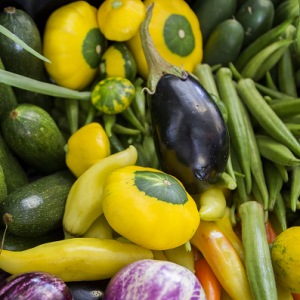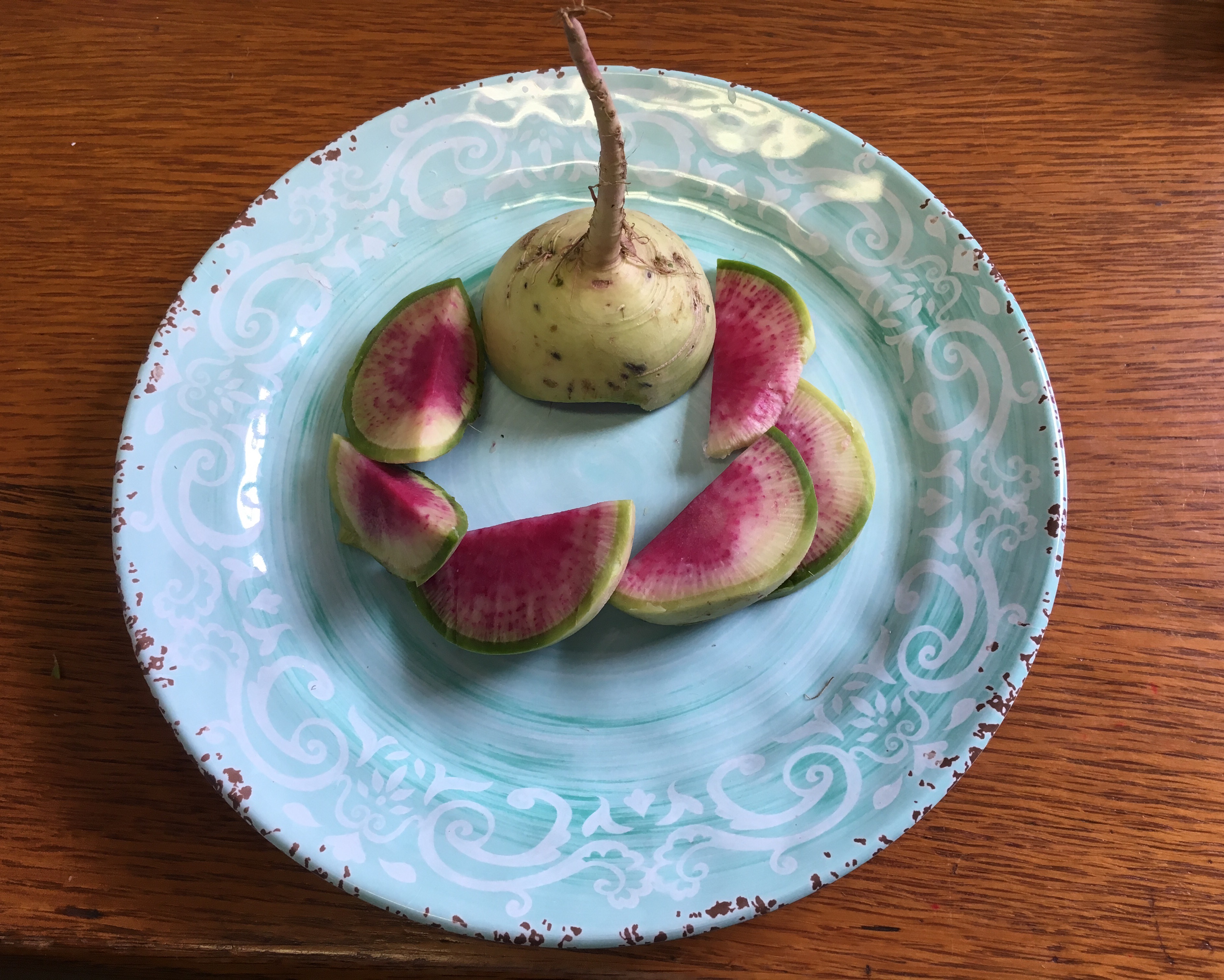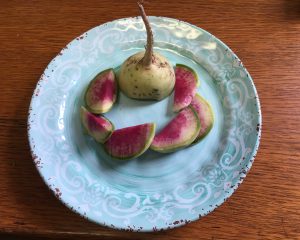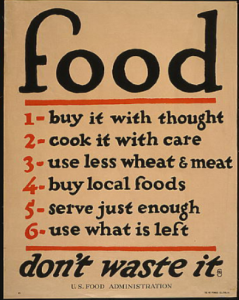by Samantha Kennedy | May 27, 2017
 North Florida’s beautiful spring weather means we get to enjoy a variety of delicious, locally-grown fruits and veggies during the summer months. Produce such as bell peppers, squash, tomatoes, greens, corn, cucumbers, okra, peas, eggplant, and a variety of melons are plentiful and fresh from late spring through early fall.
North Florida’s beautiful spring weather means we get to enjoy a variety of delicious, locally-grown fruits and veggies during the summer months. Produce such as bell peppers, squash, tomatoes, greens, corn, cucumbers, okra, peas, eggplant, and a variety of melons are plentiful and fresh from late spring through early fall.
The benefits of eating fresh fruits and vegetables are numerous and well-known. Fruits and veggies provide important vitamins and minerals that are vital to keeping your body working properly. They’re rich in fiber, which is important for digestive health and helps lower cholesterol. They provide antioxidants, which can help reduce your risk of a variety of cancers. They’re low in calories, fat, and sodium, which make them an ideal snack. And their colorful spectrum makes them a beautiful and healthy addition to any meal.
The MyPlate https://www.choosemyplate.gov/MyPlate guidelines call for making half your plate fruits and vegetables as part of a balanced meal. But remember, preparation is key. Steamed, roasted, raw, baked, and grilled veggies will provide the biggest nutritional bang for your buck, allowing the natural flavors to shine through. Deep fried, breaded veggies add unnecessary fat and calories, so be careful not to rely on this cooking method too often.
Mix and match! Pair a leafy green with a starchy vegetable for a wider spectrum of nutrients. Add fruits such as mandarin oranges or dried cranberries to a salad for a little extra sweetness. Try new flavor combinations by adding herbs and spices – but go easy on the salt!
While fresh fruits and vegetables are healthy, delicious, and plentiful during Florida’s summer months, frozen and canned varieties, including juices, can also provide many of the same health benefits. However, be sure to read the label carefully before buying. Look for low sodium or no salt varieties and only purchase 100% juice beverages, as other drinks may contain a lot of artificial flavorings and colors.
For more information about the benefits and uses of fresh North Florida produce, please visit the Panhandle Produce Pointers page at: http://wfrec.ifas.ufl.edu/panhandle-produce-pointers/produce-pointers-sheets/.

by Laurie Osgood | May 23, 2017
Radishes are an easy vegetable to grow in North Florida, and in the Spring, there is an abundance of radishes in our gardens. So, what do you do with all those radishes?
 Radishes are a fast growing vegetable that can grow from a seed to a plant in less than 30 days. Radishes are a root vegetable belonging to the Brassicaceae (mustard or cabbage) family. Radishes vary in size, taste, and color. Radishes can be eaten raw, oven roasted, or pickled. The length of time radishes are allowed to grow affects their taste. The longer they are in the ground, the spicier they become.
Radishes are a fast growing vegetable that can grow from a seed to a plant in less than 30 days. Radishes are a root vegetable belonging to the Brassicaceae (mustard or cabbage) family. Radishes vary in size, taste, and color. Radishes can be eaten raw, oven roasted, or pickled. The length of time radishes are allowed to grow affects their taste. The longer they are in the ground, the spicier they become.
Radishes contain only 19 calories per serving, are high in vitamin C, and contain other important nutrients such as folate, potassium, and fiber. According to the Centers for Disease Control, eating vegetables like radishes may help reduce the risk of many diseases, including heart disease, high blood pressure, and some cancers.
Radishes add color, flavor, and texture to coleslaws, salads, and side dishes. When oven roasting root vegetables like radishes, their natural sugars are released, bringing out their sweet, nutty flavors!
Here is a light and flavorful coleslaw recipe for all of those freshly picked radishes. Adding granny smith apples and thinly sliced radishes to traditional coleslaw makes it sweet, peppery, and delicious!
|
Cabbage, Apple, and Radish Coleslaw
Serves: 8 Prep Time: 10 minutes
|
| INGREDIENTS:
5 cups of shredded cabbage, red or green
1 cup granny smith Apples, cut into small pieces
¾ cup radish, cut into small pieces
2 tablespoons white onions, diced
DRESSING:
¼ cup sugar
¼ cup cider vinegar
1.5 tablespoons water
1.5 tablespoons oil
1/8 teaspoon celery seed
1/8 teaspoon dry mustard
A pinch of salt and pepper
INSTRUCTIONS:
Mix cabbage, radishes, apples, and onions in large mixing bowl.
In smaller bowl, combine sugar, vinegar, water, oil, mustard, celery seed, and salt and pepper, and mix well.
Add dressing to cabbage mix and stir well. Place in refrigerator and chill for 30 minutes before serving. |
To learn more about Radishes, visit the FDACS website at: http://www.freshfromflorida.com/content/search?SearchText=radishes
Cabbage, Radish, Apple Coleslaw recipe courtesy of Blackberrybabe.com: blackberrybabe.com/2016/05/23/cabbage-radish-apple-cole-slaw/
To learn more about Chronic Disease Prevention and Health Promotion, visit the CDC Website at https://www.cdc.gov/chronicdisease/

by Laurie Osgood | May 10, 2017
The watermelon radish is a member of the mustard family, which includes arugula, broccoli, and turnips. It has an edible round white root with a green stem and leaves. The inside flesh is rimmed in white with a dark pink circular pattern, resembling a watermelon, and is crisp and sweet, with a mild peppery taste.

SEASONS/AVAILABILITY
Watermelon radishes are as easy to grow as other radish varieties and can be ordered through online seed catalogs. However, they may take longer to mature than other types of radishes (about 65 days). They are available all year long, with peak growing seasons in the spring and late fall. High temperatures and warm soil can have an effect on the radish’s flavor, making the fruit taste bitter.
NUTRITIONAL VALUE
The fruit, root, and leaves of the watermelon radish provide an excellent source of fiber, vitamin C, and other nutrients, particularly when eaten raw.
SELECTING AND SERVING
When shopping for watermelon radishes, select those that are firm, without bruises or cracks. Watermelon radishes can be served fresh or cooked, hot or cold. Cooking the watermelon radish will enhance its natural sweetness. This fruit’s vibrant color is perfect for topping salads and sandwiches. Watermelon radishes are delicious when pickled.
PICKLED WATERMELON RADISHES
- 1 to 2 watermelon radishes
- ½ cup distilled white vinegar
- ½ cup water
- 1 teaspoon sugar
- 1 teaspoon salt
- ½ teaspoon peppercorns, lightly crushed
- 2 cloves garlic, peeled
- Thoroughly wash radishes, slice into ½ inch-thick discs, and place into clean canning jar.
- In a medium saucepan, bring vinegar, water, sugar, salt, peppercorns, and garlic to boil. Simmer one minute. Pour hot liquid over radishes in canning jar.
- Let cool to room temperature, top with canning lid, and store in the refrigerator.
Yield: 1 cup
The watermelon radish is a low maintenance, easy to grow plant. Only a basic level of care is required to ensure that it thrives. Taking care of its basic growing needs (soil, sun, and water) will result in a strong plant that will make a vibrant and healthy addition to your summer recipes.

by Laurie Osgood | May 3, 2017

Mother’s Day is Sunday, May 14, 2017, and it is a great time for us to celebrate our hard-working mothers. It is also a good time to talk to your mother about her health history. Knowing your mother’s health history may help improve your own health.
According to the Centers for Disease Control (CDC), a family health history is a record of the diseases and health conditions in your family. They advise you to collect information about your entire family, including any major medical conditions so you can provide your doctor with an accurate picture of your family’s health history and genetics.
8 IMPORTANT QUESTIONS TO ASK YOUR MOTHER:
- HOW’S YOUR HEART? According to the American Heart Association, heart disease is the number one killer of women, and the genetic risk is high. Although you probably know if your mother has had a heart attack in her lifetime, you may not know if other family members have suffered from high blood pressure or heart disease.
- HAVE YOU EVER HAD CANCER? It is important to know if your mother or anyone in her family has had a cancer diagnosis, but it is also essential to know what type of cancer, when it occurred, and what type of treatment was required for their cancer. This will help your doctor determine when to suggest certain screenings.
- DO YOU HAVE ANY HISTORY OF TYPE 2 DIABETES? Type 2 diabetes is one of the diseases that can be passed down to you from your mother. If your mother has ever been diagnosed with diabetes, that information must be included in your medical history.
- WHAT WAS YOUR PREGNANCY LIKE? Pregnancy-related conditions like gestational diabetes, pre-eclampsia, and fertility issues can be inherited.
- WHAT WAS MENOPAUSE LIKE? Daughters can expect to reach menopause around the same time as their mother did. Some of the symptoms of menopause can be difficulty sleeping and hot flashes. These symptoms can be eased with foods rich in Omega 3s, such as fish oil, walnuts, seafood, and spinach.
- HAVE YOU EXPERIENCED ANY MENTAL HEALTH DIFFICULTIES? Mental health issues can be inherited as well, so this information should be included in your family history.
- HAVE YOU EVER HAD EYE PROBLEMS? Glaucoma is a disease that may typically appear in older adults. Heredity is known to play a key role in all types of glaucoma.
- DO YOU HAVE OSTEOPOROSIS SYMPTOMS? A family history of bone density problems can indicate your own chances of developing osteoporosis or other bone difficulties as you get older.
Conversations about health can be particularly difficult between parents and children, as they are not the normal topic of conversation on Mother’s Day. However, knowing your mother’s health history can help you take better care of yourself and can be an opportunity to improve the health of the next generation in your own family.
Resource: https://www.cdc.gov/features/familyhealthhistory/index.html
by Amy Mullins, PhD, RDN | Apr 3, 2017
 It’s no secret that exercise is good for you and can improve your life in so many ways. The idea of exercise can be daunting for some people, especially if you’ve never done it on a regular basis. You don’t have to go to the gym and lift weights or run a half -marathon to “exercise.” It’s important to keep in mind that many different types of physical activity can be considered exercise and can get you on the path to feeling great every day.
It’s no secret that exercise is good for you and can improve your life in so many ways. The idea of exercise can be daunting for some people, especially if you’ve never done it on a regular basis. You don’t have to go to the gym and lift weights or run a half -marathon to “exercise.” It’s important to keep in mind that many different types of physical activity can be considered exercise and can get you on the path to feeling great every day.
Benefits of physical activity include:
- Increasing your chances of living longer
- Feeling better about yourself
- Decreasing your chances of becoming depressed
- Sleeping well at night
- Moving around more easily
- Having stronger muscles and bones
- Achieving and maintaining a healthy weight
- Being with friends or meeting new people
- Enjoying yourself and having fun!
Consider some new ways to become active such as:
- Volunteering within your community
- Taking group walks around the neighborhood
- Taking up gardening and growing vegetables or flowers
- Doing stretches and chair exercises throughout the day and while watching TV or on the computer.
The idea is to find FUN activities that will keep you moving, active, and engaged. If you decide to start a more rigorous exercise regimen, make sure to ask your doctor first.
Always keep proper hydration in mind, especially when exercising outdoors during the summer heat. Dehydration is a leading cause of hospitalization and serious health problems for older adults. Signs and symptoms of dehydration include headaches, constipation, muscle cramps, dry mouth, sleepiness, and rapid heart rate. It’s important to hydrate yourself with at least eight 8-oz. cups of water during the day. Stay ahead of the game and don’t wait until you’re thirsty to drink… by then, you are already dehydrated.
The National Institutes of Health, National Institutes on Aging recommend making these five tips a priority everyday:
- Try to be physically active for at least 30 minutes on most or all days of the week
- Eat plenty of fruits and vegetables
- Choose foods that are low in added sugars, saturated fats, and sodium
- Pick whole grains and lean sources of proteins and dairy products
- Practice all four types of exercise: endurance, strength, balance, and flexibility
For more information about exercise, hydration, nutrition, and safety for older adults, visit https://go4life.nia.nih.gov/.
by Heidi Copeland | Apr 3, 2017
Earth Day: an issue of sustainability!
 Have you ever thought about Earth Day, you know, that one day a year that falls on April 22nd?
Have you ever thought about Earth Day, you know, that one day a year that falls on April 22nd?
Earth Day was founded in 1970 by Gaylord Nelson, a U.S. Senator from Wisconsin, and sought to focus on the environment and how we can create healthy and sustainable surroundings. Almost a half-century later, the principals of Earth Day remain the same, and we continue to come up with ways to preserve, or make our environment a sustainable one.
As a consumer, what can we do to practice environmental sustainability?
We have many opportunities, Take food for instance. As a nation not only are we becoming super-sized but so is our food-related waste.
In August of 2012, the Natural Resources Defense Council (NRDC) issued a paper explaining that America Is Losing Up to 40 Percent of Its Food from Farm to Fork to Landfill. Yes, that is right; nearly 40 percent of our food supply is wasted (yet, one in eight Americans struggles to put food on the table).
The reasons for such waste are multifaceted; however, consumers are a major contributor to the problem. Key findings include:
The average American family of four ends up throwing away an equivalent of up to $2,275 annually in food.
In average American households, 2/3 of household waste is due to food spoilage:
40 percent of fresh fish
23 percent of eggs
20 percent of milk
Citrus fruits and cherries top the list for fruits, and sweet potatoes, onions, and greens are commonly wasted vegetables
Other household waste includes:
cooking too much
serving too much
over purchasing
plate waste
holiday celebrations
Wasted food also translates into wasted natural resources. It takes energy, water and farmland to grow, transport, and store food. Additionally, food waste is the single largest component of solid waste in U.S. landfills. By wasting less food, each of us can be an essential component in solving this increasing problem.
In 1917, the U.S. Food Administration distributed war effort posters in hopes of convincing the public to conserve food resources with expectations that this campaign would maintain an adequate supply of food for the troops fighting wars as well as for American households.
These century old practices are applicable today.
- Buy it with thought! We can be mindless in the way we purchase food in much the same way we can be mindless in how we eat our food. Make thoughtful purchases, as wise choices are better for both our planet and our body.
- Cook it with care. In the end, checking items we have on hand, planning menus and shopping with care makes us mindful and aware.
- Use less wheat & meat. In fact, Meatless Mondays was a sustainable war effort too! Practicing this use less effort provokes mindful eating of resource intense products.
- Buy local. Hardly a buzzword, the idea has been around for a long time. By mindfully purchasing local products, we are not stuffing items into our grocery carts without reflection on where the food comes from.
- Serve just enough. Choose My Plate, https://www.choosemyplate.gov/MyPlate gives a great visual representation of the foods each of us need on our plate. Not only can serving enough help our wallet, but it can help our waistline!
- Use what is left. Using what we have is a wise use of resources for both Mother Nature, personal finances and our health. Try eating your leftovers instead of throwing them into the landfill.
Norman Vincent Peale says, Change your thoughts and you change your world. Can the same thinking apply to our behavior? If each and every one of us made a small behavior change it could help change the world and make us better stewards of our environment, not just on April 22nd, but every day.
FOR MORE INFORMATION:
https://www.nrdc.org/issues/food-waste
http://www.nrdc.org/living/eatingwell/saving-leftovers-saves-money-resources.asp
 North Florida’s beautiful spring weather means we get to enjoy a variety of delicious, locally-grown fruits and veggies during the summer months. Produce such as bell peppers, squash, tomatoes, greens, corn, cucumbers, okra, peas, eggplant, and a variety of melons are plentiful and fresh from late spring through early fall.
North Florida’s beautiful spring weather means we get to enjoy a variety of delicious, locally-grown fruits and veggies during the summer months. Produce such as bell peppers, squash, tomatoes, greens, corn, cucumbers, okra, peas, eggplant, and a variety of melons are plentiful and fresh from late spring through early fall.







